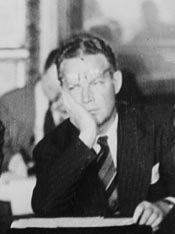Arnold Heeney
(lawyer, diplomat, civil servant, deep state actor) | |||||||||||||||||||||
|---|---|---|---|---|---|---|---|---|---|---|---|---|---|---|---|---|---|---|---|---|---|
 In 1946 | |||||||||||||||||||||
| Born | 1902-04-05 Montreal, Quebec | ||||||||||||||||||||
| Died | 1970-12-20 (Age 68) Ottawa, Ontario | ||||||||||||||||||||
| Nationality | Canadian | ||||||||||||||||||||
| Alma mater | University of Manitoba, Oxford University, McGill University | ||||||||||||||||||||
| Member of | Rhodes Scholar/1923 | ||||||||||||||||||||
Deep State Canadian civil servant, then Ambassador to the United States. When PM Diefenbaker showed signs of independence, Heeney spent much time lobbying his own government against it.
| |||||||||||||||||||||
Arnold Danford Patrick Heeney was a Canadian lawyer, diplomat and civil servant.
He was born in Montreal, Quebec. He was educated at St. John's College, Winnipeg and received a Bachelor of Arts degree in 1921 and a Master of Arts degree in 1923 both from the University of Manitoba. As the Manitoba Rhodes Scholar he went on to St. John's College, Oxford before returning to Canada, earning a Bachelor of Civil Law degree at McGill University.
Specializing in Maritime law, in 1929 he joined the Montreal law firm of Meredith, Holden, Heward & Holden. In one of his last cases with the firm, he successfully represented F. R. Scott against the City of Westmount.
In 1938, he took the position of Principal Secretary to Prime Minister William Lyon Mackenzie King. From 1940 to 1949, he was Clerk of the Privy Council and Secretary to the Cabinet. He organized the work of the Cabinet War Committee, the key ministers, and made his office a clearing point for information and advice.[1] He was perhaps the most important civil servant during World War II.
In 1949, he became Under Secretary of State for External Affairs, then Ambassador to the North Atlantic Treaty Organization.
He was Canada's Ambassador to the United States from 1953 to 1957 and 1959 to 1962. Heeney’sfirst posting was challenging and stimulating; the second term was more taxing as relations between the United States and Canada became even more strained, exacerbated by Prime Minister Diefenbaker's attempt to assert Canadian independence. In Heeney’s attempts to promote greater understanding between policy makers in Washington and Ottawa, he spent much time lobbying his own government. Heeney was particularly alarmed by anti-American rhetoric and policies.[2]
Until shortly before his death, he was Canadian head of the International Joint Commission and the Permanent Joint Board on Defence, both bilateral organizations with the United States.[3]
In 1968, he was made a Companion of the Order of Canada. He died in Ottawa in 1970.
Events Participated in
| Event | Start | End | Location(s) | Description |
|---|---|---|---|---|
| Bilderberg/1957 February | 15 February 1957 | 17 February 1957 | US St Simons Island Georgia (State) | The earliest ever Bilderberg in the year, number 5, was also first one outside Europe. |
| Bilderberg/1962 | 18 May 1962 | 20 May 1962 | Sweden Saltsjöbaden | The 11th Bilderberg meeting and the first one in Sweden. |
| Bilderberg/1964 | 20 March 1964 | 22 March 1964 | US Virginia Williamsburg | A year after this meeting, the post of GATT/Director-General was set up, and given Eric Wyndham White, who attended the '64 meeting. Several subsequent holders have been Bilderberg insiders, only 2 are not known to have attended the group. |